Fetal blood vessel count increases in compensation of hypoxia in premature placentas
Main Article Content
Abstract
Article Details
Issue
Section
The journal allows the authors to hold the copyright without restrictions and allow the authors to retain publishing rights without restrictions.
How to Cite
References
World Health Organizatin. MDG 4: reduce child
mortality. Geneva: World Health Organization;
Blencowe H, Cousens S, Chou D, et al. Born too
soon: the global epidemiology of 15 million
preterm births. Reprod Health 2013;10(Suppl
:52:1-14.
World Health Organization. Born too soon: the
global action report on preterm birth. Geneva:
World Health Organization; 2012.
Hutter D, Kingdom J, Jaeggi E. Causes and
mechanisms of intrauterine hypoxia and its
impact on the fetal cardiovascular system: a
review. Int J Pediatr 2010. doi: 10.1155/2010/
Zamudio S, Wu Y, Letta F, et al. Human placental
hypoxia-inducible factor-1α expression
correlates with clinical outcomes in chronic
hypoxia in vivo. Am J Pathol 2007;170:2171-9.
Oladipupo S, Hu S, Kovalski J, et al. VEGF is
essential for hypoxia-inducible factor-mediated
neovascularization but dispensable for
endothelial sprouting. PNAS 2011;108:13264-
Hecht J, Allred E, Kliman H, et al. Histological
characteristics of singleton placentas delivered
before the 28th week of gestation. Pathology 2008;
:372-6.
Mongia SM, Jain SK, Yadav M. Placenta: the
wonder organ. J Indian Acad Forensic Med 2011;
:140-2.
Soni R, Nair S. Study of histological changes in
placenta of anaemic mothers. IOSR-JDMS 2013;
:42-6.
Saga Z, Minhas LA, Rana R. Effects of altitude
on morphology of human placenta with special
reference to terminal vili and syncytial knots.
Int J Pathol 2008;6:26-9.
Biswas S. Placental changes in idiopathic
intrauterine growth restriction. OA Anatomy
;1:1-7.
Majumdar S, Dasgupta H, Bhattacharya A. A
study of placenta in normal and hypertensive
pregnancies. J Anat Soc India 2005;54:34-8.
Salafia C, Popek E. Inflammatory and vascular
placental pathology. Glob Libr Women’s Med
doi: 10.3843/GLOWN.10152.
Kiran N, Zubair A, Khalid H, et al.
Morphometrical analysis of intervillous space
and villus membrane thickness in maternal
anaemia. J Ayub Med Coll Abbottabad 2014;26:
-11.
Carter AM. Maintaining the integrity of
trophoblast during growth of the placenta. Focus
on “insulin-like growth factor I and II regulate
the life cycle of trophoblast in the developing
human placenta”. Am J Physiol Cell Physiol
;294:1303-4.
Bainbridge SA, Belkacemi L, Dickinson M, et
al. Carbon monoxide inhibits hypoxia/
reoxygenation-induced apoptosis and secondary
necrosis in syncytiotrophoblast. Am J Pathol
;169:774-83.
Baergen R. Manual of pathology of the human
placenta. 2nd ed. New York: Springer; 2011.
Belkacemi L, Bainbridge SA, Dickinson M, et
al. Glyceryl trinitrate inhibits hypoxia/
reoxygenation-induced apoptosis in the
syncytiotrophoblast of the human placenta. Am
J Pathol 2007;170:909-20.
Burton G, Jauniaux E. The maternal circulation
and placental shape: villus remodeling induced
through haemodynamics and oxidative and
endoplasmic reticulum stress. In: Burton G,
Barker D, Maffett A, et al, editors. The placenta
and human developmental programming.
Cambridge: Cambridge University Press;2011.
p.161-74.
Nagi A. A monograph placenta examination and
pathology. Biomedica 2011;27:81-99.


